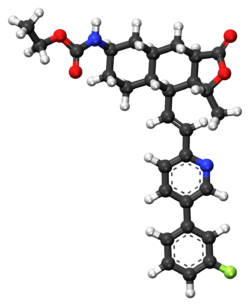Vorapaxar
 |
|
 |
|
| Clinical data | |
|---|---|
| Trade names | Zontivity |
| Pregnancy category |
|
| Routes of administration |
Oral |
| ATC code | |
| Legal status | |
| Legal status |
|
| Pharmacokinetic data | |
| Bioavailability | ~100% |
| Protein binding | ≥99% |
| Metabolism | hepatic (CYP3A4 and CYP2J2) |
| Biological half-life | 5–13 days |
| Excretion | feces (58%), urine (25%) |
| Identifiers | |
|
|
| Synonyms | SCH-530348 |
| CAS Number | |
| PubChem CID | |
| IUPHAR/BPS | |
| ChemSpider | |
| UNII | |
| ChEBI | |
| ChEMBL | |
| ECHA InfoCard | 100.116.767 |
| Chemical and physical data | |
| Formula | C29H33FN2O4 |
| Molar mass | 492.58 g/mol |
| 3D model (Jmol) | |
| Melting point | 278 °C (532 °F) |
|
|
|
|
|
|
|
Vorapaxar (brand name Zontivity, formerly known as SCH 530348) is a thrombin receptor (protease-activated receptor, PAR-1) antagonist based on the natural product himbacine, discovered by Schering-Plough and developed by Merck & Co.
Vorapaxar is used for persons with a history of myocardial infarction (heart attack) or persons with peripheral arterial disease. Studies have shown that this medication can reduce the rate of combined endpoint cardiovascular death, MI, stroke, and urgent coronary revascularization.
Vorapaxar is contraindicated for people with a history of stroke, transient ischemic attack, or intracerebral hemorrhage. In studies of vorapaxar on persons with prior ischemic stroke, there was an increased risk of intracranial hemorrhage without an improvement in major vascular events. Vorapaxar possesses a long half life which is a problem because there is currently no treatment to reverse the antiplatelet effects of vorapaxar. Because of this, it is important that vorapaxar not be used in persons with history of stroke, transient ischemic attack, or intracranial hemorrhage, or active pathological bleeding. This family of medication, PAR-1 antagonists in general has been associated with an increased risk of intracranial bleeding demonstrated by a pooled analysis of data that studied 42000 patients with history of thrombotic vascular disease or acute coronary syndrome comparing the medication and a placebo.
Vorapaxar is eliminated primarily by metabolism by the CYP3A enzymes. It is best to avoid any strong CYP3A4 inhibitors(ex: ketoconazole, itraconazole, posaconazole, clarithromycin, nefazodone, ritonavir, saquinavir, nelfinavir, indinavir, boceprevir, telaprevir, telithromycin, and conivaptan). CYP3A4 inducers(Carbamazepine, rifampin, St. John's Wort, and Phenytoin) should also be avoided.
No dose adjustment is required in persons with renal impairment. No dose adjustment is required in persons with mild and moderate hepatic impairment. If the person has severe hepatic impairment, vorapxar is not recommended due to the risk of bleeding.
Vorapaxar is a new anti-platelet drug that is part of the PAR-1 antagonist family, a new class of anti-platelet drug. It functions by inhibiting thrombin-related platelet aggregation. This mechanism works by a different pathway than other anti-platelet medications such as aspirin and P2Y12 inhibitors. Unlike many other medication, vorapaxar does not affect ADP-mediated platelet aggregation, coagulation parameters, or bleeding time.
...
Wikipedia
